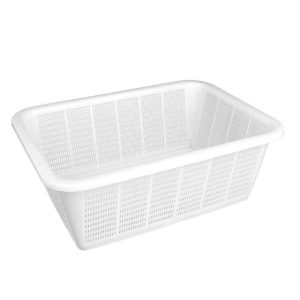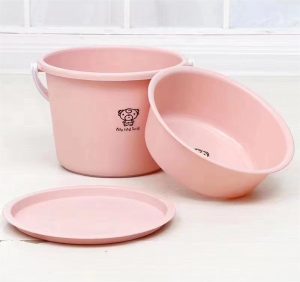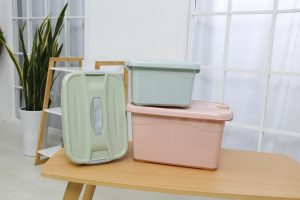3. Engineering plastics
ABS
ABS resin is a product of the copolymerization of three monomers, acrylonitrile-butadiene-styrene, referred to as ABS terpolymer. Due to the different proportions of its components A (acrylonitrile), B (butadiene) and S (styrene) in the composition, as well as differences in manufacturing methods, the properties of this plastic are also very different. ABS is suitable for injection molding and extrusion processing, so its main use is to produce these two types of products. ABS resin has eye-catching colors, is heat-resistant, and is strong. The outer surface can be plated with chrome, nickel and other metal films, and can be used to make piano keys, buttons, knife holders, TV casings, umbrella handles, etc.
Polysulfone (PSF)
It was first developed and put into production by Union Carbide Corporation (UCC). In 1986, the company transferred its polysulfone production and sales rights to Amoco. In addition, major polysulfone manufacturers include BASF of Germany, ICI of the United Kingdom, and Shevchink of Russia. Global polysulfone production has exceeded 40,000 tons, and my country’s production capacity is 1,500 tons.

Polyimide (PI)
PI is currently one of the best heat-resistant varieties among engineering plastics. Some varieties can withstand high temperatures of 290°C for a long time and 490°C for a short time. They are also resistant to extremely low temperatures. For example, they will not be brittle in liquid helium at -269°C. crack. In addition, the mechanical properties, fatigue resistance, flame retardancy, dimensional stability, and electrical properties are all good. The molding shrinkage is small. It is resistant to oil, general acids and organic solvents, not alkali resistant, and has excellent friction resistance and wear properties. And PI has no poison, can be used to make tableware and medical utensils, and can withstand thousands of sterilizations.
Polyamide (PA, common name: nylon)
It has won people’s attention due to its unique low specific gravity, high tensile strength, wear resistance, good self-lubricating properties, excellent impact toughness, and both rigid and flexible properties. In addition, it is easy to process, has high efficiency, and has a light specific gravity (only 1 of metal). /7), can be processed into various products to replace metal, and are widely used in the automobile and transportation industries. Typical products include pump impellers, fan blades, valve seats, bushings, bearings, various instrument panels, automotive electrical instruments, hot and cold air conditioning valves and other parts. Each car consumes approximately 3.6 to 4 kilograms of nylon products. Polyamide consumes the largest proportion in the automotive industry, followed by electronics and electrical.

Polyphenylene ether (PPO)
Referred to as PPO. It has excellent comprehensive performance. Its biggest feature is its excellent dimensional stability and outstanding electrical insulation under long-term load. It has a wide operating temperature range and can be used for a long time in the range of -127~121℃. It has excellent water resistance and steam resistance, and the products have high tensile strength and impact strength, as well as good creep resistance. In addition, it has better wear resistance and electrical properties. Mainly used to replace stainless steel in manufacturing surgical medical instruments. In the mechanical and electrical industry, it can be used to make gears, blower blades, pipes, valves, screws and other fasteners and connectors. It is also used to make parts in the electronic and electrical industry, such as coil bobbins and printed circuit boards.
4. Special engineering plastics
Polyphenylene sulfide (PPS)
It has good affinity with various inorganic fillers. After enhanced modification, its physical and mechanical properties and heat resistance (thermal deformation temperature) can be improved. Reinforcement materials include glass fiber, carbon fiber, polyaramid fiber, metal fiber, etc. Mainly fiberglass. Inorganic fillers include talc, kaolin, calcium carbonate, silica, molybdenum disulfide, etc.
PPS/PTFE, PPS/PA, PPS/PPO and other alloys have been commercialized. PPS/PTFE alloy improves the brittleness, lubricity and corrosion resistance of PPS. PPS/PA alloy is a high toughness alloy.
Glass fiber reinforced PPS has excellent thermal stability, wear resistance, creep resistance, excellent mechanical and electrical properties in a wide range (temperature, humidity, frequency), small dielectric quantity and low dielectric loss. Low. As a high-temperature resistant and anti-corrosion coating, the coating can be used for a long time at 180°C; in the electronic and electrical industry, it is used as connectors, insulating partitions, terminals, and switches; in machinery and adhesive machinery, it is used in pumps, gears, piston ring storage tanks, and blades Valve parts, watch parts, camera parts; carburetors in the automobile industry. Distributor components, electronic and electrical components, gas valves, sensor components; home appliance components include tape recorder structural components, body diodes, and various parts; the other is also used in the aerospace and aviation industries. PPS/PTFE can Make anti-stick, wear-resistant parts and transmission parts, such as shaft pumps.
PI is used in aviation, automobiles, electronic appliances, industrial machinery, etc. It can be used as engine combustion system parts, jet engine components, compressor and generator parts, fasteners, spline joints and electronic connectors. It can also be used as Automobile engine parts, bearings, piston sleeves, timing gears, printed circuit boards, insulating materials, heat-resistant cables, terminals, sockets in the electronics industry, high-temperature self-lubricating bearings, compressor blades and piston machines in the mechanical industry. Seals, equipment heat shields, thrust washers, bushings, etc.
Polyetheretherketone (PEEK)
Polyetheretherketone (PEEK) resin is a crystalline, super heat-resistant thermoplastic polymer. It has physical and chemical properties such as high temperature resistance and chemical corrosion resistance, and can be used as high temperature resistant structural materials and electrical insulation materials. Through modification, PEEK can achieve higher physical properties. For example, it can be blended with polytetrafluoroethylene (PTFE), polyethersulfone (PESU), etc. to meet different usage requirements. J.Denault and Lin S H respectively use glass fiber (GF), carbon fiber (CF) and other composite-reinforced PEEK resins to improve the material’s service temperature, rigidity, dimensional stability and impact performance; nanomaterial-filled PEEK composite materials have better hardness, tensile strength and The tensile strength and tensile modulus are 20%-50% higher than that of pure PEEK, thus further expanding its application scope.

Liquid Crystal Polymer (LCP)
Because of its high strength, high rigidity, high temperature resistance, and excellent electrical insulation, it is used in fields such as electronics, electrical, optical fibers, automobiles, and aerospace. Fibers made of liquid crystals can be made into fishing nets, bulletproof clothing, sporting goods, brake pads, optical fiber and display materials, etc. They can also be made into films for soft printed circuits, food packaging, etc. Thermotropic liquid crystal polymer can also be made into polymer blend materials with a variety of plastics. In these blend materials, the liquid crystal polymer acts as fiber reinforcement, which can greatly improve the strength, rigidity and heat resistance of the material.
Post time: 06-12-2024



